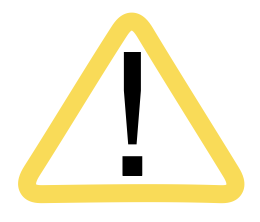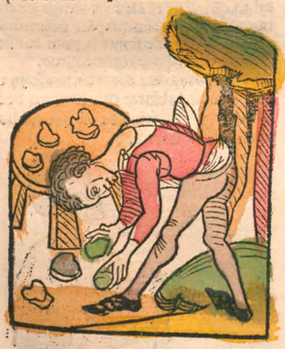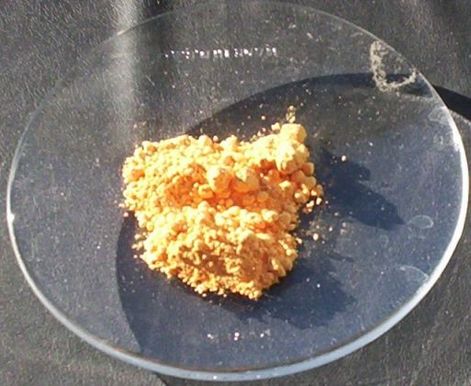Sentry Page Protection
Hortus sanitatis, 1491
Mineralogical Name:
Yellow Lead monoxide
Litharge (formed from fused and powdered Massicot)
Three types of Litharge were mentioned by Pliny:
1. Chrysitis (Gold colored, best; also called German Gold Litharge);
2. Argyritis (German Silver Litharge)
3. Molybditis (fused from Lead); also called Hearth Lead.
Litharge was said to be "an excrement arising from the refining of Silver or Gold with Lead; it is twofold: either White or Yellow (called Litharge of Silver or Gold) but they only differ in boiling; for the Yellow is that which is most boiled or burnt, and is indeed only Lead half calcined". (Salmon)
Burnt Lead is similar in use to to Litharge.
Parts used:
Prepared Lead
Temperature & Taste:
Cold, dry
"According to Galen its temperament inclines towards desiccation but is weak in warming and cooling actions. Some other people, however, consider it to be inclining towards coldness. The litharge, which is treated with water, is, undoubtedly cold" (Avicenna)
Classifications:
2L. EMOLLIENT 2T. GLUTINATE 2X. INCARNATIVE 2Z. CICATRIZING
TCM:
T. External Medicines
Yellow Lead monoxide
Litharge (formed from fused and powdered Massicot)
Three types of Litharge were mentioned by Pliny:
1. Chrysitis (Gold colored, best; also called German Gold Litharge);
2. Argyritis (German Silver Litharge)
3. Molybditis (fused from Lead); also called Hearth Lead.
Litharge was said to be "an excrement arising from the refining of Silver or Gold with Lead; it is twofold: either White or Yellow (called Litharge of Silver or Gold) but they only differ in boiling; for the Yellow is that which is most boiled or burnt, and is indeed only Lead half calcined". (Salmon)
Burnt Lead is similar in use to to Litharge.
Parts used:
Prepared Lead
Temperature & Taste:
Cold, dry
"According to Galen its temperament inclines towards desiccation but is weak in warming and cooling actions. Some other people, however, consider it to be inclining towards coldness. The litharge, which is treated with water, is, undoubtedly cold" (Avicenna)
Classifications:
2L. EMOLLIENT 2T. GLUTINATE 2X. INCARNATIVE 2Z. CICATRIZING
TCM:
T. External Medicines
Uses:
1. Clears Damp-Heat, Kills Parasites, Cleanses Sores and Ulcers: (TCM, Ayurveda, West)
-externally for Moist Sores with exudating fluid, and Fungal infections;
-Eczema, Scabies, and chronic and persistent Ulcers;
-dissolved in Vinegar or Rose water it is applied to Prickly Heat, Eczematous Eruptions, Acne, and to remove Freckles.
-Salmon said it ‘Generates flesh, fills up hollow Ulcers’.
-Recognised as a Specific for Syphilis and Syphilitic sores in Ayurveda (when purified).
-"The white and treated varieties of litharge are used in collyrium. It clears the Eye". (Avicenna)
2. Heals Fractures:
-in Ayurveda to aid in the healing of Fractures (as is Minium), and externally applied to help keep dislocated parts in their place once reduced.
3. Stops Leakage:
-diarrhea, dysentery and dysentery-like disorders;
-Salmon lists it for these and ‘other diseases of the bowels: it cures and consolidates the Intestines being hurt or exulcerated’. (TCM, West)
4. Clears Heat:
-‘It Cools the Blood and abates the heat of Urine’. (Salmon)
5. Clears Phlegm, Calms Fright:
-internal acumulation of Phlegm, and Convulsions due to fright (TCM).
-similarly used for Wind and Phlegm diseases in Ayurveda.
6. Kills Worms:
-the purified product is used for Worms in Ayurveda and Unani.
7. Cosmetic and Hair Uses:
-"clears freckles, black marks and Hematoma" (Avicenna)
-"It gives fragrant odour to the body and armpits" (Avicenna)
-"Treated litharge particularly removes the marks of Small Pox" (Avicenna)
-Oil is prepared by boiling Litharge in it; it gives the Hair a black colour. Also applied as an ointment for Baldness and Alopecia. (Ayurveda)
8. Used in Alchemy:
-Helps to solidify Mercury in Alchemical operations.
Dose:
1–2 grams. Salmon gave a dose of ½ dram.
Unani texts give a dose of 1 mithqal (4.4 grams) followed by Sesame oil taken in the morning for Worms.
Correctives:
1. Milk
2. Sugar
3. Ghee
4. Almond or Sesame oil
Preparation:
1. Avicenna gave several methods of preparation:
(a) boiling in vinegar or wine,
(b) burning once or twice on live-coal and collecting the supernatant,
(c) boiling with wheat or barley in water, removing the cereals till they burst open and boiling the rest again with fresh water till the material becomes pure and settles down at the bottom. The procedure is repeated several times followed by cleansing with salt. Sometimes other methods are also adopted for this purpose.
(d) "They keep it in clay-pots used for storing water to reduce its harmful effects" (Avicenna)
In Ayurveda, either of the followings methods can be used to purify Litharge:
1. Litharge is powdered well in a mortar and pestle, and put into a glass vessel. A concentrate (saturated) solution of Rock Salt is added, enough to cover the Litharge by 2 inches. This is to be stirred with a wooden spoon at least once a day. After every 7 days, the solution should be replaced. This is continued for at least 40 days (often longer). It is then well washed with pure water 7 times. The powder should be dried and kept in a properly sealed glass bottle.
2. It may also be impregnated with the juices of Citrus medica and Ginger for 3 times; this involves steeping and triturating Litharge in the juices, and allowing the juice to dry, before adding more juice and repeating; it is repeated 3 times. This is generally used externally in ointments etc., and so it not generally further prepared.
1–2 grams. Salmon gave a dose of ½ dram.
Unani texts give a dose of 1 mithqal (4.4 grams) followed by Sesame oil taken in the morning for Worms.
Correctives:
1. Milk
2. Sugar
3. Ghee
4. Almond or Sesame oil
Preparation:
1. Avicenna gave several methods of preparation:
(a) boiling in vinegar or wine,
(b) burning once or twice on live-coal and collecting the supernatant,
(c) boiling with wheat or barley in water, removing the cereals till they burst open and boiling the rest again with fresh water till the material becomes pure and settles down at the bottom. The procedure is repeated several times followed by cleansing with salt. Sometimes other methods are also adopted for this purpose.
(d) "They keep it in clay-pots used for storing water to reduce its harmful effects" (Avicenna)
In Ayurveda, either of the followings methods can be used to purify Litharge:
1. Litharge is powdered well in a mortar and pestle, and put into a glass vessel. A concentrate (saturated) solution of Rock Salt is added, enough to cover the Litharge by 2 inches. This is to be stirred with a wooden spoon at least once a day. After every 7 days, the solution should be replaced. This is continued for at least 40 days (often longer). It is then well washed with pure water 7 times. The powder should be dried and kept in a properly sealed glass bottle.
2. It may also be impregnated with the juices of Citrus medica and Ginger for 3 times; this involves steeping and triturating Litharge in the juices, and allowing the juice to dry, before adding more juice and repeating; it is repeated 3 times. This is generally used externally in ointments etc., and so it not generally further prepared.
Main Combinations:
1. Rosacea, with Sulphur in Rose water or a cooling ointment topically.
2. Abscesses, with Frankincense, made into an ointment with Wax and Oil.
3. Abscess of the Vagina, with Aloe, Myrrh, Frankincense, Dragon's Blood, Zinc oxide, made into a salve with wax and oil of Roses
Major Formulas:
Diachilon Plaster (Emplastrum Diachilon)
Plaster for Cancer (Wirtzung)
Plaster of Calamine
Cautions:
1. Lead is virtually obsolete because of its accumulative and toxic effects. Lead is, however, still occasionally used internally in Eastern systems, usually after preparation such as Bhasma.
2. Never used in pregnancy or young children.
3. If used internally it is not used for more than 2–3 weeks without a break in treatment.
3. In cases where it is used internally, it should not be used for more than 1–2 weeks without a break in treatment.
4 However, some external preparations may still be applicable as lead forms insoluble compounds when it comes into contact with albumen.
5. "Litherge is a fatal poison. It stops the urine and inflates the bowels as also areas pertaining to ureters. It whitens the
tongue and also causes dyspnea.". (Avicenna)
Toxicity:
Lead Bhasma was studied for toxicity. Short-term use showed no toxic effects in Albino rats when histopathologically studied post-mortem. High doses or long-term use did show some pathological changes of the vital organs.
Main Preparations used:
Salt of Litharge
SALT of LITHARGE. (Paracelsus)
‘It is done with distilled Vinegar, as Salt of Lead, decanting the solution, filtering, and inspissating’.
‘It cures Diarrheas, Dysenteries, Lienteries, Ulcers in the Guts &c. Cools the Blood and heat of the Urine, and has all the virtues of Saccharum Saturni. Dose: ½ dram in Mithridate or any Sudorific Electuary’. (Paracelsus, Salmon)
1. Lead is virtually obsolete because of its accumulative and toxic effects. Lead is, however, still occasionally used internally in Eastern systems, usually after preparation such as Bhasma.
2. Never used in pregnancy or young children.
3. If used internally it is not used for more than 2–3 weeks without a break in treatment.
3. In cases where it is used internally, it should not be used for more than 1–2 weeks without a break in treatment.
4 However, some external preparations may still be applicable as lead forms insoluble compounds when it comes into contact with albumen.
5. "Litherge is a fatal poison. It stops the urine and inflates the bowels as also areas pertaining to ureters. It whitens the
tongue and also causes dyspnea.". (Avicenna)
Toxicity:
Lead Bhasma was studied for toxicity. Short-term use showed no toxic effects in Albino rats when histopathologically studied post-mortem. High doses or long-term use did show some pathological changes of the vital organs.
Main Preparations used:
Salt of Litharge
SALT of LITHARGE. (Paracelsus)
‘It is done with distilled Vinegar, as Salt of Lead, decanting the solution, filtering, and inspissating’.
‘It cures Diarrheas, Dysenteries, Lienteries, Ulcers in the Guts &c. Cools the Blood and heat of the Urine, and has all the virtues of Saccharum Saturni. Dose: ½ dram in Mithridate or any Sudorific Electuary’. (Paracelsus, Salmon)
Salmon, Seplasium:
|
'It is of two sorts, 1. Litharge of Silver, which is white; and Litharge of Gold, which is yellow. But they are both made in the purification of Silver with Lead, differing only in the boiling, for the yellow (which is called Litharge of Gold, from its color) is that which is most boiled; so that it is only a kind of burnt Lead'.
|
'It thickens, softens, fills up hollow Ulcers, represses the Excrescencies of the Flesh, cicatrizes, refrigerates, and stops Fluxes of Humors. It is used in a Collyrium for the Eyes, takes away Spots, Wrinkles, Scabs, Tetters, and other deformations of the Face and Skin. It is repercussive, Detersive, and Sarcotic, filling Ulcers up with flesh'.
|




